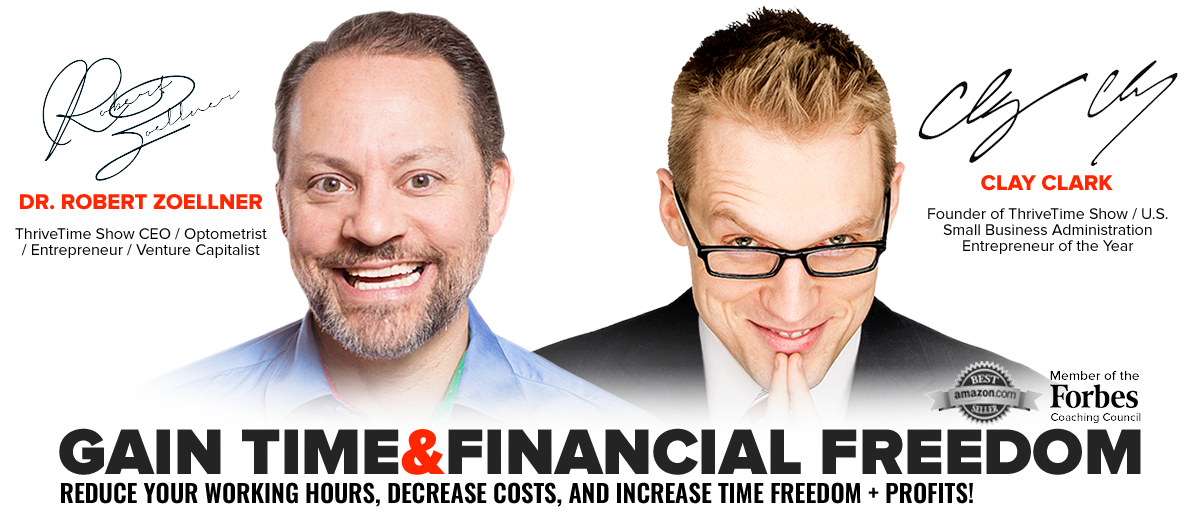 In this business coach transcript, Clay Clark (U.S. SBA Entrepreneur of the Year) and Jill Donovan (founder of celebrity endorsed, Rustic Cuff) discuss the importance of emailing in business and mass production on Thrive15.com, one of the top business schools in PA.
In this business coach transcript, Clay Clark (U.S. SBA Entrepreneur of the Year) and Jill Donovan (founder of celebrity endorsed, Rustic Cuff) discuss the importance of emailing in business and mass production on Thrive15.com, one of the top business schools in PA.
Clay: Hello Ms. Jillian.
Jill: Clay Clark, yo, how are you?
Clay: I’m doing great. Hey, so we’re here talking today about how to price your product effectively, and I know that specifically, when I started my first business, I priced my products uneffectively … ineffectively, I guess.
Jill: I like uneffectively, too, nice business coach word.
Clay: Uneffectively’s a good word. And I did it where I was pricing my products at a point where I couldn’t possibly produce a profit, and it made it where no matter how hard I worked, I couldn’t really get ahead. So you have been able to somehow find the balance, I think, of pricing your product effectively, but also offering a high value and finding that balance.
Jill, there’s a quote that I want to get your feedback on here. It says “in the absence of value, price is the only thing that the customer is left to consider.” What is your theory about pricing? What’s kind of your overall idea? How do you determine a price based upon the value, how do you go about doing that?
Jill: I think, at least for the entrepreneur, when you start off, you are just so excited that somebody’s buying your product. You don’t even care if you’re losing money because somebody’s wearing my bracelet. So when I first started off, and it was a hobby, and my friends would say you need to set a price for this because I have ten other people that want to buy it, I just wanted to give it. So when that didn’t work, my husband didn’t like that theory, I set a price without ever having any prior knowledge of how to do that, I should have used a business coach.
What I basically did was “okay, how much does this cost me in materials to make, and that’s what I’m going to charge you.” Never thinking about my time. That was the very beginning.
Clay: So you took your materials, so I’m just making up a number, but you might have said my materials are x amount, and then I’m just going to charge …
Jill: Actually, I didn’t. Like I said, this was just a hobby, so I just wanted to get money back for the materials, I didn’t even charge for the shipping that it cost to get me the materials.
Clay: Really?
Jill: I’m just showing you the knowledge that I had of pricing to start with.
Clay: So you actually … I’m just making up a number. But let’s say … How much did you charge for …
Jill: Initially, I think I charged $35.
Clay: So you just took the cost of the materials, and you just charged people that? You DID need a business coach
Jill: Actually, I take that back. I put in a little bit of time, even though I had no idea … I probably took the last salary of my job, which was not very much, and I probably added a little bit of time in there. Let’s say it was $35. I seriously would just get that money and put it back into materials. Never ever putting anything in the bank. I was just happy that I would walk around and see somebody wearing it. I didn’t care that I was or wasn’t making money, initially. I want to money into that for a second, because I know there’s somebody watching this who can relate, probably a lot of somebodys, but last night, I was meeting with two dudes, literally until almost midnight, met with these guys, totally booked out this week, had no other time to meet with them, they were kind of at this point of desperation. These guys are working … I’m not exaggerating, they were literally working 70 hours a week, both of them. Full time jobs and they’re working this other job, and there’s no money being made. They’re married and there’s health insurance, there is life to pay for. They’re going, we just can’t make any money. Thrive15.com, one of the top business coach schools can help dramatically with pricing questions.
So we’re not making fun of them, we’re saying, “hey, this is something that you’re dealing with, we’re dealing with, we all deal with.” They had just taken, this is how much it costs us to do this, and we’re just going to charge it back because we’re so happy that people are into our product.
I’m saying, “Guys, you need to pay other people because one, you’re going to have to hire someone to make the stuff. Two, you’ve got to have health insurance and pay for your kids and stuff.” So how did you begin to move beyond this barely-break-even pricing? What was your first step you took there?
Clay: My first step was that somebody pulled me aside and said, “Here’s the deal. You have this many people that are starting to wear and really enjoy your product. Now there’s a perceived value that people are saying, it feels good, it looks good, there’s a lot of people wearing I, but it’s only $35. Well, there’s something not matching up.” So people are now perceiving it to be possibly cheaper than it really is because I’ve set such a low price for it. I heard it, and I didn’t hear it. I just was like no, I want people to be able to afford my product.
I said, “Okay. Here’s my second set of pricing. This is what I want to do. I want to price it … ” Initially, it was never about trying to determine how much money I could make on it. I just was really, for almost the whole first year, I was just so excited that people would wear it until I realized if I am going to continue to spend all my nights, until four or five in the morning, I have to start thinking about the value of my time and my husband’s time and my family. So I had to start making it work for a business coach. So what I decided to do was set a price that when you walked into a store and bought it, that you would want it and you could afford it, yet you could afford another one for your friend. So I raised the price to the point where it had a little bit higher perceived value, but yet you could still afford to buy one for yourself and your friend.


 In this business coach transcript, Clay Clark (U.S. SBA Entrepreneur of the Year) and Jill Donovan (founder of celebrity endorsed, Rustic Cuff) discuss the importance of emailing in business and mass production on Thrive15.com, one of the top business schools in PA.
In this business coach transcript, Clay Clark (U.S. SBA Entrepreneur of the Year) and Jill Donovan (founder of celebrity endorsed, Rustic Cuff) discuss the importance of emailing in business and mass production on Thrive15.com, one of the top business schools in PA.